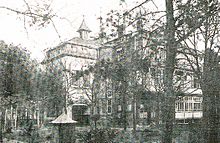Max Lochner

Max Lochner (born June 30, 1868 in Aachen , † November 22, 1949 in Mainz-Gonsenheim ) was a German hippologist and holder of numerous patents .
Live and act
The son of the Aachen cloth manufacturer Emil Lochner and Leonie, b. Haniel (1846–1911), daughter of the manor owner Max Haniel and his wife Friederike, b. Cockerill (1816–1854), daughter of the steel entrepreneur James Cockerill , had to end her father's training as a violinist at the Brussels Conservatory because of a muscle injury. After a 1-year training in his father's company, Max Lochner finally received military training at the war school in Anklam . After the death of his father in 1900, Lochner resigned from the military service of the artillery with the rank of captain.
Max Lochner, who was always very connected to equestrian sports, moved to Mainz-Gonsenheim in 1905 and built the so-called Lochner-Hof with stables, riding arena and dressage arena as well as a luxurious villa with 34 rooms. The latter was occupied by the French military, including Algerian Sipahi , both from 1920 to 1927 and from 1945 , and demolished in 1955. Lochner joined the Reit- und Fahrverein e. V. 1929 Mainz-Gonsenheim and took over the supervision of the light department , with which he achieved considerable success in 1934/35.
In addition, he began to deal intensively with the sitting posture of the rider on the horse and the saddle construction and wrote several publications , some of which were under the pseudonym : Hengist Horsa , which were very popular at the time. Lochner particularly emphasized the weight impact of the rider and highlighted it as the most essential.
As an energetic advocate of the split seat, which Antoine de Pluvinel already described as ideal, Lochner rejected the English flatbed saddle with its two focal points (bracket attachment and seat). He preferred the American cowboy saddle, developed it further with two movable seat cushions and then patented it as a special Lochner saddle that was gentle on the back . He also received a patent for his theses on the humane treatment of the horse as a creature.
Max Lochner was also interested in technical things at a young age. Among other things, he shared his brother Erich Lochner's enthusiasm for flying and later, according to Rüdiger Haude's publication: Grenzflug, Politische Symbolik der Luftfahrt before World War I (Böhlau-Verlag, 2007), “introduced and reported a novelty for aircraft that can no longer be identified today patent to (Herz 2000: 94) ". According to the minutes of the meeting of May 2, 1914, Max Lochner was also a member of the free balloon department of the German Aviation Association (DLV).
Using his knowledge developed over the aircraft Max Lochner 1912 streamlined car, called the egg , which he at his own expense 120,000.00 Reichsmarks of Opel had built. It is one of the few cars with a body that is aerodynamically shaped at the time. The cross-section was almost circular and you could stand upright in the egg even at a maximum speed of 95 km / h, as the roadholding and suspension allowed this. Even with a top hat , getting in and out was unhindered and, thanks to the good sealing of the interior, it was only slightly dusty considering the road conditions at the time. The red painted Opel egg , patented under the tax formula “13 / 30PS” , was confiscated during the First World War and has since disappeared.
Lochner also acquired numerous other patents, for example on a retractable winter garden door, an in-house telephone and a footstool with runners.
Max Lochner was married twice and had six children.
Works (selection)
- Basics of air technology: Common treatise on a new theory to solve the flight question and the problem of the steerable airship , Kühl, Berlin, 1899
- Training of riding horses and riders , ES Mittler & Sohn, Mainz, Berlin, 1915
literature
- In Memoriam Max Lochner , obituary in the specialist journal St. Georg, Hamburg, December 1949
- Anita Herz: The Lochnerhof in Gonsenheim, formerly Luisenstraße 8 , in: Yearbook of the Heimat- und Geschichtsverein Gonsenheim , 1999 edition
- Anita Herz: childhood and youth memories from the end of the war in Lochnerhof tell former tenants , in: Yearbook of the Heimat- und Geschichtsverein Gonsenheim , 1999 edition
- Thomas Lochner: The story of the Aachen cloth manufacturer Johann Friedrich Lochner and his family , Schnell-Verlag, Warendorf 2013, pp. 108–116
Web links
- Mention of Max Lochner in the section Aachen horse experts (PDF; 868 kB)
- Chronicle of the Mainz-Gonsenheim riding and driving club
| personal data | |
|---|---|
| SURNAME | Lochner, Max |
| BRIEF DESCRIPTION | German hippologist and holder of numerous patents |
| DATE OF BIRTH | June 30, 1868 |
| PLACE OF BIRTH | Aachen |
| DATE OF DEATH | November 22, 1949 |
| Place of death | Mainz-Gonsenheim |


